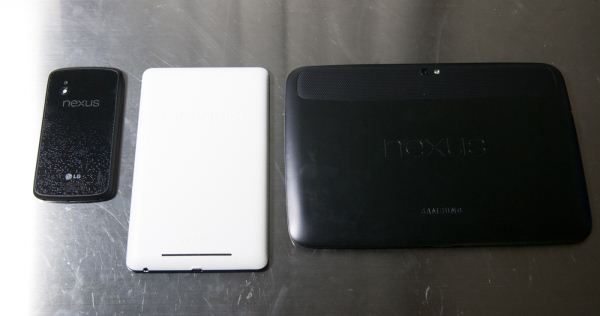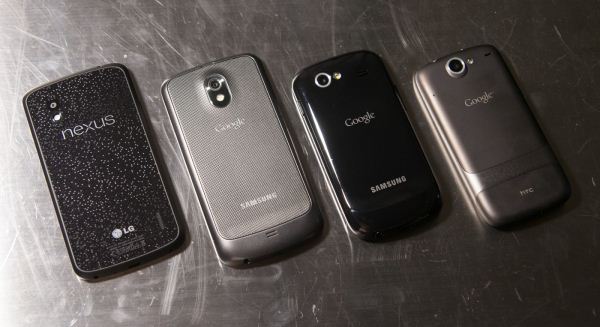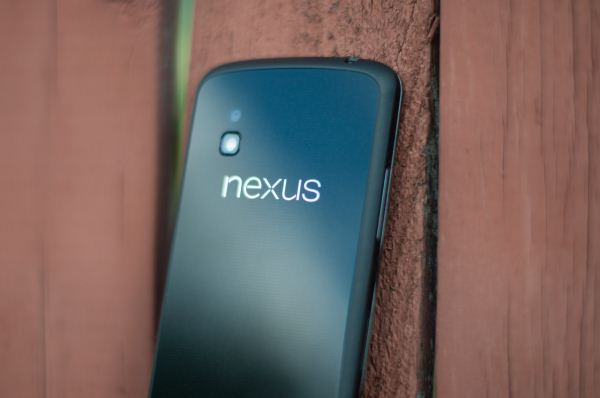Google Nexus 4 Review - Google's new Flagship
by Brian Klug on November 13, 2012 8:45 AM EST- Posted in
- Smartphones
- LG
- Android
- Mobile
- APQ8064
- Nexus 4
- Android 4.2
- MDM9215
With the Nexus 4 conclusion I really have to finish the way I started, namely by noting that this is now the fullest realization of Google's original strategy laid out for Nexus at its inception. The Nexus One had extremely aspirational goals for a first-gen Googlephone — it tried to change the way that phones are sold in the US and tried to deliver a fully carrier-agnostic reference platform for developers and OEMs to build out from. The end of that story is something everyone is familiar with, however — the Nexus One was largely a commercial failure. Little did we all know it would take several more iterations of the Nexus hardware and Android platform to get close to delivering on those goals, and Google has inched closer each time.
The next revisions of Nexus built on this platform, but only with Galaxy Nexus and its pentaband WCDMA radio and Nexus 4 do we see the fullest realization of this dream. Over time Google has built up the infrastructure required to deliver on its goals with things like the Play Store, a reputation among hardware vendors, and the right combination of hardware and software cadence to make this all work. The price point with the Nexus 4 is now low enough to not make off-contract sale an impossible to swallow deal.
With the Nexus 7 I felt like we were truly seeing the Nexus line come into its own. With Nexus 4 and 10 we're now seeing Google finally deliver a product lineup with offerings in each of the major size tiers. We now have a form factor of device for every two inches of diagonal difference.
With the Optimus G, LG truly went all the way toward delivering the best of everything it had to offer from all the different parts of LG — LG Chem, LG Innotek, LG Display. I'm very positive about the Optimus G hardware and very positive about the Nexus 4 as its close relative. LG's execution in the smartphone space has primarily been held back by its software approach and skins, and until recently a lack of updates. Getting a win for LG in the Nexus space basically mitigates that, as the software burden becomes entirely Google's, and obviously Nexus will continue to mean the latest and greatest Android platform updates for quite some time.
You can go back and read what I've written about the Nexus 4 hardware — in a word it's superb. In-hand feel is awesome thanks to the rubber ring running around the perimeter of the Nexus 4, and build quality is also very good. I've fully disassembled my Nexus 4 three times and put it together without issue, and the Nexus 4 has taken a few trips to the floor (my fault) without any adverse effects.
Finally, there's also the matter of price. For $299 you can get the latest and greatest hardware and 8 GB of storage, and for $349 you can get double that storage with 16 GB (12.92 GB usable). Both are fully unlocked and carrier-agnostic, and at those prices the Nexus 4 pretty much blows the doors off of any other unlocked or out of contract smartphones, which usually end up being priced at around $600 or more.
If you're an Android enthusiast, the Nexus 4 is obviously the phone to have right now. The combination of APQ8064 and MDM9x15 is excellent in spite of some unfortunate thermal throttling, and we'll be seeing many more Fusion 3 based devices in time at prices well above the Nexus 4 out of contract. At a fundamental level there is quite literally no better vehicle out there for Google to communicate its smartphone platform via than the yearly Nexus refresh. On its own, the Nexus 4 would otherwise be phenomenally great hardware. As a Nexus, it's a level even beyond that.
Google has come an exceptionally long way since that first Nexus One.













188 Comments
View All Comments
Rits - Tuesday, November 13, 2012 - link
Mean nothing in real life. The N4 flies through tasks in practical usage. Bring me an iPhone5 and show me how it is faster in any way. Synthetic benchmarks are, for the most part, useless. Esp, cross-platform ones.PeteH - Tuesday, November 13, 2012 - link
Depends. In most cases I agree with you, but if you're interested in a phone capable of, for example, playing state of the art (for a mobile device) games, certain graphical benchmarks are useful.Granted most users won't care about that, but most users don't read AnandTech.
lilmoe - Wednesday, November 14, 2012 - link
The iPhone 5 isn't faster, its software is more optimized. Chrome is well known to really "suck" in javascript and scrolling performance on Android. Even Dolphin Browser beats it in each performance category. Samsung's stock browser on the SGS3 is probably the best Android browser out there, I wonder how well it would perform on the Nexus 4's CPU. Chrome is nice for syncing bookmarks across all your devices in addition to some stuff, but otherwise, it really sucks.In the GPU benchmark tests where the A6 (PowerVR SGX543 MP3) beats the APQ 8064 (Snapdragon S4 Pro's Adreno 320), These are sub-scores (sub-tests) that don't really show the "big picture". They test the GPU of the platform for several shader-centric tasks. Those who use these benchmarks are looking for specific numbers for specific purposes.
What really matters in GLBenchmark for most consumers is the "Egypt Classic" and "Egypt HD" tests. These tests show the gaming/GPU performance of the platform as a whole, with the former testing "generic" 3D gaming capabilities, and the latter testing for the most modern demanding games (that stresses the platform/shaders for most fillrate, vertex, and compute performance. It's mostly over-kill and you wont see games demanding the same anytime soon). You'll easily achieve 60fps with any game you run on the Nexus 4 even with a higher resolution than the iPhone 5...
The Nexus 4 should prove to be better performing and more "future-proof" than the iPhone 5, since it has a faster CPU (quad core Krait VS dual core Swift) and a GPU that supports future standards like OpenGL ES 3.0, Open CL and Renderscript, unlike the PowerVR inside the A6 chip. Software optimization is a non-issue since it can be tuned-up in future updates or different browsers from Play Store in the case of the web browser.
There are lots of metrics to consider in cross-platform/cross-OS benchmarking, and there's absolutely NO benchmark that will show the true difference of performance among different platforms, especially with "Android VS Android" or "Android VS iOS" because each Android OEM utilizes different hardware and different software optimizations (in addition to other factors, like thermal throttling in this review's case). That's probably not the case when comparing the iPhone 5 versus the 4S or even a Windows Phone 8 devices versus another device running the same OS because both platforms use vertically integrated hardware/software, but that's where firmware and driver version differences start to kick in, but it's closer to reality than anything related to Android.
Red Oak - Tuesday, November 13, 2012 - link
And also, no LTE. Comical. Certainly for the US marketantef - Tuesday, November 13, 2012 - link
Not at half the price of other phones. Also Android and especially Nexus is an open platform, so that automatically shuts the door on CDMA and consequently the biggest LTE carrier in the US. Nobody who has good HSPA+ cares.Penti - Tuesday, November 13, 2012 - link
In Europe you get pretty good carrier support with just quad band LTE which is showing up now. All USIM, plus Band 7, Band 20, Band 8, Band 3 covers most here and is available in most countries. In Sweden we started on Band 7 and now runs networks at Band 20 and Band 8 too. So we can actually get devices now which runs on all the frequencies either in use or that will be refarmed. Similar in other countries here. Most carriers has a few bands. You do need to support more then one. More troublesome in the US obviously. It is looking up finally though. DC-HSPA+ is up an running too so, even in small communities. It's not bad, at least not if you are able to use wifi for heavier/larger stuff.antef - Tuesday, November 13, 2012 - link
Clearly the Nexus 4 is not named as such because it's the 4th Nexus phone like you mention. If that was the case the Nexus 7 and 10 would throw a wrench in that wouldn't it? It's named that way because the screen is 4(.7)". If you look at the Nexus logo on the site they even de-emphasize the number by making it a small superscript to "nexus" and saying "now in three sizes." The fact that it's the 4th Nexus is just a coincidence. I would expect them to keep these names going forward and just release a Nexus 4 2nd gen, 3rd gen, etc.Rits - Tuesday, November 13, 2012 - link
Correct.tarunactivity - Tuesday, November 13, 2012 - link
The iPhone 5 resolution is 1136x640-pixel , not 1136x960 ...http://www.apple.com/iphone/specs.html
stotticus - Tuesday, November 13, 2012 - link
Of what city are those pictures?